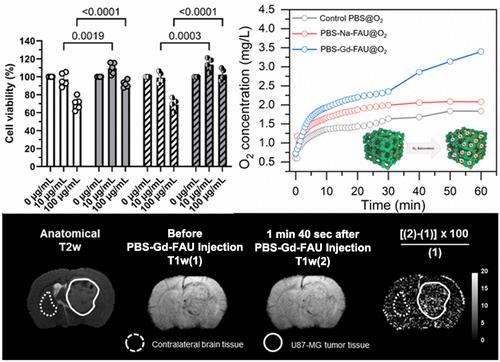Injectable Biocompatible Zeolite Nanocrystals for Enhanced Tumor Oxygenation and MRI Imaging
IF 8.2
2区 材料科学
Q1 MATERIALS SCIENCE, MULTIDISCIPLINARY
引用次数: 0
Abstract
Tumor hypoxia significantly limits the effectiveness of radiotherapy, as oxygen is crucial for producing cancer-killing reactive oxygen species. To address this, we synthesized nanosized faujasite (PBS-Na-FAU) zeolite crystals using clinical-grade phosphate-buffered saline (PBS) as the solvent, ensuring preserved crystallinity, microporous volume, and colloidal stability. The zeolite nanocrystals showed enhanced safety profiles in vitro and ex vivo, and in vivo studies showed no apparent toxicity to animals. They demonstrated a high oxygen capacity with a release rate of 2.68 mg/L under hypoxic conditions. The introduction of gadolinium (Gd3+) into the zeolite nanocrystals by ion exchange, replacing three monovalent cations (Na+ and K+), led to an increased oxygen capacity of the sample. In situ Fourier transform infrared (FTIR) study revealed that Gd-containing zeolite (PBS-Gd-FAU) adsorbed ∼23% more oxygen at 20 kPa compared to the as-synthesized sample (PBS-Na-FAU). In vivo magnetic resonance imaging (MRI) demonstrated targeted oxygen delivery and release within brain tumors, revealing 14.91 and 17.10% differences in cerebral blood volume (CBV) between tumor and contralateral brain tissue after 15 and 20 min, respectively, compared to the control. T1 maps at 7 T indicated a relaxation rate of 9.254 mM–1·s–1 for PBS-Gd-FAU, twice that of commercial Gd-chelates. These findings highlight the potential of Gd-containing zeolite nanocrystals synthesized in PBS as a biocompatible platform for enhancing tumor oxygenation in anticancer therapy, with significant clinical translation potential.

可注射的生物相容性沸石纳米晶体增强肿瘤氧合和MRI成像
肿瘤缺氧明显限制了放射治疗的有效性,因为氧气对于产生杀死癌症的活性氧至关重要。为了解决这个问题,我们使用临床级磷酸盐缓冲盐水(PBS)作为溶剂合成了纳米faujasite (PBS- na - fau)沸石晶体,确保了结晶度、微孔体积和胶体稳定性。沸石纳米晶体在体外和离体实验中显示出更高的安全性,在体内研究显示对动物没有明显的毒性。在低氧条件下,它们表现出高氧容量,释放率为2.68 mg/L。通过离子交换将钆(Gd3+)引入沸石纳米晶体中,取代三个单价阳离子(Na+和K+),导致样品的氧容量增加。原位傅里叶变换红外(FTIR)研究表明,与合成样品(PBS-Na-FAU)相比,含gd沸石(PBS-Gd-FAU)在20 kPa下吸附的氧气多23%。体内磁共振成像(MRI)证实了脑肿瘤内的靶向氧传递和释放,与对照组相比,肿瘤和对侧脑组织在15和20分钟后的脑血容量(CBV)分别差异14.91和17.10%。7 T时的T1图谱显示PBS-Gd-FAU的松弛速率为9.254 mM-1·s-1,是商业gd -螯合物的两倍。这些发现突出了在PBS中合成的含gd沸石纳米晶体作为生物相容性平台在抗癌治疗中增强肿瘤氧合的潜力,具有重要的临床转化潜力。
本文章由计算机程序翻译,如有差异,请以英文原文为准。
求助全文
约1分钟内获得全文
求助全文
来源期刊

ACS Applied Materials & Interfaces
工程技术-材料科学:综合
CiteScore
16.00
自引率
6.30%
发文量
4978
审稿时长
1.8 months
期刊介绍:
ACS Applied Materials & Interfaces is a leading interdisciplinary journal that brings together chemists, engineers, physicists, and biologists to explore the development and utilization of newly-discovered materials and interfacial processes for specific applications. Our journal has experienced remarkable growth since its establishment in 2009, both in terms of the number of articles published and the impact of the research showcased. We are proud to foster a truly global community, with the majority of published articles originating from outside the United States, reflecting the rapid growth of applied research worldwide.
 求助内容:
求助内容: 应助结果提醒方式:
应助结果提醒方式:


